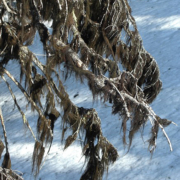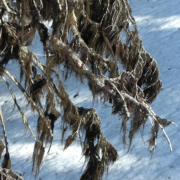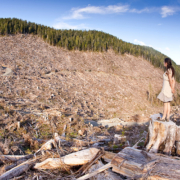$100 – Stu Crawford, Vancouver
*** The auction closes on Thursday, December 15th, 2011 at 12:00pm (noon) PST. ***
Here’s your chance to name a new species and help protect the spectacular, endangered ancient forests in British Columbia, Canada!
The scientific naming rights to a newly discovered species of lichen are being auctioned-off as a fundraiser for the Ancient Forest Alliance, a British Columbian non-profit conservation organization.
Canadian botanical researcher Trevor Goward discovered the new species of bryoria or “horsehair lichen” in the inland temperate rainforest of British Columbia. Goward is donating the naming rights for the new species to the Ancient Forest Alliance to help the organization raise funds for its conservation campaigns – and to help create a model to encourage other taxonomists around the world who discover new species to donate their naming rights to conserve endangered species and ecosystems!
WHY Should YOU Make a Bid for this New Species?
1. Your name would be enshrined as a legacy that could endure as long as our civilization lasts!
Having your name – or that of a loved one, your favourite celebrity, role model, hero, sports team – linked to a living species is a legacy that lasts a long time. It has been almost three centuries since the modern system of biological classification was developed by Carolus Linnaeus; and even now the names of people after whom he christened various plants and animals are still with us. With any luck your name will endure as long as our civilization does. Not even Shakespeare could hope for more than that!
2. It will help set a precedent for a potentially successful new way to raise millions of dollars for conservation around the world!
Thousands of new species are described by taxonomists every year. If this fundraiser is successful, it will help to create a model that could convince other taxonomists to support conservation organizations, raising millions of dollars for conservation around the world for the Earth’s diverse ecosystems and biodiversity!
3. You will greatly help British Columbia’s leading – and leanest – environmental organization working at the forefront of the campaign to protect British Columbia’s endangered old-growth forests.
The old-growth forests of British Columbia are among the most magnificent forests on the planet, harbouring trees with trunks as wide as living rooms and that tower as tall as downtown skyscrapers. These forests are home to some of the largest and most charismatic animal species on Earth, including grizzly bears, mountain lions, wolves, and mountain caribou, and some of the most endangered species, like the spotted owl and white-headed woodpecker.
The Ancient Forest Alliance has generated huge media coverage, public awareness, and policy influence in less than 2 years since its founding – with only a tiny fraction of the funding base compared to other major environmental organizations. The organization has built vital new support among tourism businesses, First Nations, politicians, forestry workers, and a large diversity of citizens that will ultimately lead to success if the campaign is adequately funded.Media Release
New Lichen Species Names to be Auctioned off as Environmental Fundraisers to Protect British Columbia’s Wilderness Areas
Naming rights to two recently discovered species of lichens will be auctioned off as fundraisers for two B.C. environmental groups: The Land Conservancy (TLC) of British Columbia (
www.conservancy.bc.ca), working to purchase private lands in the Clearwater River Valley adjacent to Wells Gray Provincial Park, and the Ancient Forest Alliance (AFA) (
www.ancientforestalliance.org) working to protect B.C.’s old-growth forests primarily on public lands.
The two lichen species were discovered in B.C. in recent years by botanical researcher Trevor Goward. Since then their identity as undescribed species has been supported by two teams of molecular researchers working in Finland and Spain. According to scientific protocol, the right to give a new species its scientific name goes to the person who describes it. However, an online auction running on each organization’s website into the fall will earn the highest bidders the right to name these lichens – whether after loved ones, themselves, or whomever they choose.
“Having your name linked to a living species is a legacy that lasts,” says botanist and taxonomist Goward. “It has been almost three centuries since the modern system of biological classification was developed by Carolus Linnaeus; and even now the names of people after whom he christened various plants and animals are still with us. With any luck your name will endure as long as our civilization does. Not even Shakespeare could hope for more than that.”
Lichens are small, stationary organisms often mistaken for plants, but better thought of as cooperative (symbiotic) unions of fungi and algae:
https://www.waysofenlichenment.net/. Instead of invading or scavenging like other fungi, lichen fungi live off sugars from tiny photosynthetic algal cells maintained within the body of the lichen. Lichens are sometimes thought of as fungi that have discovered agriculture:
https://www.waysofenlichenment.net/ways/readings/essay1 .
Many lichens are sensitive to pollution and disturbance and become rare in urbanized and industrialized landscapes. The conversion of old-growth forests to tree plantations is taking a particularly heavy toll on the abundance and diversity of lichens in British Columbia. Some lichens provide critical winter food for animals like mountain caribou in B.C.’s inland rainforests and black-tailed deer in B.C.’s coastal rainforests.
Lichens come in many shapes and sizes. The lichen on loan to the Ancient Forest Alliance is a
Bryoria or “Horsehair Lichen”, which forms elegant black tresses on the branches of trees in oldgrowth forests. The Land Conservancy’s lichen is a
Parmelia or “Crottle Lichen”, consisting of strap-like lobes pale greyish above and black below. It too inhabits the branches of trees, and grows in the Clearwater Valley, where TLC is working with Goward to create a critical wildlife corridor for southern Wells Gray Park:
https://waysofenlichenment.net/wells/corridor project.
Goward is an internationally acclaimed lichenologist who has described about two dozen species and genera of lichens, mostly in western Canada. He is curator of lichens at the University of British Columbia and author of several books. His work can be found at:
https://www.waysofenlichenment.net/portal. Goward lives in the Clearwater Valley near Wells Gray Provincial Park north of Kamloops, B.C. Recently Goward has come out in support of environmental groups, starting with the Ancient Forest Alliance and The Land Conservancy, by auctioning off some of his newly discovered species through the process he refers to as “taxonomic tithing”:
https://www.waysofenlichenment.net/tithe/home .
“I whole-heartedly support efforts to set aside biologically critical portions of B.C.’s forestlands. Putting my new species up for auction for two highly-deserving environmental organizations – one working to protect public lands and other private lands – allows me to give something back to my home province,” says Goward.
“We’re extremely grateful to Trevor for his very innovative fundraising and awareness raising contribution to help us protect B.C.’s last endangered old-growth forests which sustain endangered species, the climate, tourism, and many First Nations cultures. As a new organization with limited funds, we need all the help we can get,” says Ken Wu, the Ancient Forest Alliance’s Executive Director. “Our goal is to raise $100,000 in 2011 to build the most effective, large-scale public education and mobilization campaign to ensure new forest policies on our public lands.”
“In partnership with Trevor, TLC is raising funds to create a permanent wildlife corridor that connects two separate portions of southern Wells Gray Provincial Park. The acquisition will include two significant donations of land by Trevor and his neighbours and the purchase of three further parcels. This naming auction will help support our campaign and we would like to thank Trevor for choosing TLC. Trevor’s passion and commitment to protecting B.C.’s special places is commendable,” says Barry Booth, TLC Northern Regional Manager. “In addition to the wildlife corridor, this project will also protect vital wetlands and a meadow that is home to Canada’s most diverse population of Moonwort Ferns. TLC and its partners need to raise $350,000 to complete the initial stages of this project.”
A previous online auction for the naming of a new species of monkey in Bolivia netted $650,000, with proceeds going towards the protection of the monkey’s habitat. [Original article no longer available]
Those who want to make a bid to have one of the new species named after themselves or a loved one should visit
or contact The Land Conservancy at www.conservancy.bc.ca/ or phone 1-877-485-2422.
*** The auction closes on Thursday, December 15th, 2011 at 12:00pm (noon) PST. ***
More Fascinating Details about the Lichens and Taxonomic Tithing from Trevor Goward at:








